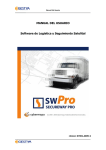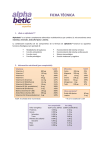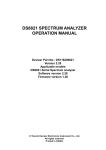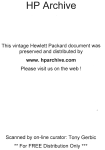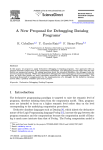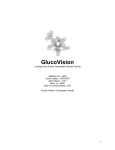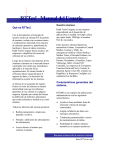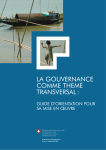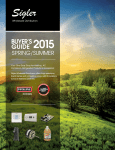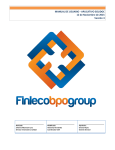Download An Exercise in Inclusive Environmental Education
Transcript
An Exercise in Inclusive Environmental Education The Development of a Bird Call Audio Guide as a Multifaceted Resource Brittany Sigler ENVR 451: Research in Panama Final Report Presented to: Dr. Rafael Samudio, Dr. Roberto Ibañez on April 26, 2013 in collaboration with McGill University Smithsonian Tropical Research Institute Parque Natural Metropolitano Sigler 2 Table of Contents Executive Summary 3 Resumen Ejecutivo 4 Coordinates of Host Organization 6 Acknowledgements 7 McGill Code of Ethics 7 Context 8 Objectives 9 Justification 10 Background: Literature Review 11 Study Site 14 Methodology 15 Results 17 Sample 20 Discussion 22 Conclusion 25 References 28 Appendices 30 Appendix A: Timeline 30 Appendix B: Expenses 30 Appendix C: Map of Parque Natural Metropolitano 31 Appendix D: Questionnaire 32 Appendix E: Questionnaire Results 33 Appendix F: Instruction Pamphlet 35 Sigler 3 Executive Summary As the sole protected area located within a city in Central America, Parque Natural Metropolitano (PNM) is presented with a unique opportunity to engage an unusually widespread and diverse visitor population in ecotourism and environmental education. Given its accessibility, it is also an ideal park for those with special needs. The problem is that PNM lacks resources for such visitors, besides lacking interactive educational tools for its visitors in general. While I was given the task of developing materials targeted to special needs visitors, I took the opportunity to create a resource that would be beneficial to all. By encouraging the enjoyment of the park’s facilities, offering unrestricted access to an environmental education tool, ensuring the accessibility of the resource for users with and without physical limitations, and choosing a digital platform, the creation of a bird call audio guide was determined to fulfill all of PNM’s vocalized objectives. My personal goals were to develop the audio guide in line with pedagogical guidelines for teaching the visually impaired, to enhance the scope of the fulfillment of PNM’s goals through the expansion of online presence, to improve the bilingual resources of PNM, and to amalgamate existing information about the birds of PNM to expand the accessibility and knowledge of PNM’s bird species. A detailed methodology and timeline were constructed to ensure the completion of the project in the tight timeframe available. Following an assessment of the park’s available resources, visitor statistics, management plan and website, the plan for the creation of the bird call audio guide was developed. Background research into the effectiveness of considering multiple senses for instruction, the use of technology in the classroom and the importance and benefits of engaging in customized learning was conducted. The bulk of the project consisted of amalgamating, in both English and Spanish, the descriptions provided in The Illustrated Field Guide to the Birds of Panama by Ernesto Ponce and Giselle Muschett, downloading the bird calls from the xeno-canto database, and finding images for each bird species included in PNM’s fauna list. The tracks were all sorted in iTunes according to scientific name, family, and order. During this process, a questionnaire was conducted at PNM with a sample track to retrieve feedback the audio guide’s progress. Finally, an instruction pamphlet was assembled for employees and visitors to the park to assist with the implementation of this new resource. The results of the questionnaire yielded an overtly positive response to this resource and to the sample track itself, including its length, speed, and difficulty level of its content. The vast majority also indicated interest in the project itself, demonstrating the need for additional interactive resources at PNM. Given the overwhelming agreement with the state of the sample track, minimal changes were made. A larger sample size, with equal representation of all age groups, would be effective for a more thorough assessment of opinions towards the final product and to determine future adaptations. Through the course of the preparatory research and its development, this bird call audio guide came to present itself as a multifaceted resource that would achieve both vocalized and non-vocalized goals of PNM. This endeavor, at its foremost, acts to make the experience of ecotourism much more educational, informative and engaging for people with and without physical limitations. An inclusive, digital, environmental education tool, the bird call audio guide encourages increased usage and appreciation of the environment of the park and its facilities. Sigler 4 This resource also has the capacity to generate increased income for the park. Lastly, it also has utility for scientists conducting listening-based experiments and censuses. There is much opportunity for the expansion of the audio guide, whether through the addition of more languages, further classification with more playlists, or further dissemination in other realms -- whether digital or physical. This tool can also act as a reference for other projects that involve audio. Overall, this bird call audio guide is a multifaceted resource that facilitates inclusive environmental education, making PNM an even more desirable destination for visitors from all backgrounds. Resumen Ejecutivo Como la única área protegida ubicada dentro de una ciudad en América Central, Parque Natural Metropolitano (PNM) tiene la oportunidad privilegiada para involucrarse con de la población visitante inusualmente amplia y diversa en el ecoturismo y la educación ambiental. Teniendo en cuenta su accesibilidad, sino que también es un parque ideal para aquellos con necesidades especiales. El problema es que PNM no tiene muchos recursos para estos visitantes, además de carecer herramientas educativas interactivas para visitantes en general. Aunque me dieron la tarea de desarrollar de materias dirigidas a los visitantes con necesidades especiales, tomé la oportunidad de crear un recurso que podría ser beneficioso para todos. En fomentando el disfrute de las instalaciones del parque, en ofreciendo acceso ilimitado a una herramienta de educación ambiental, en garantizando la accesibilidad de los recursos para los usuarios con y sin limitaciones físicas, y la elección de una plataforma digital, la creación de una audio guía de cantos de aves era capaz de cumplir todos los objetivos vocalizadas del PNM. Mis objetivos personales eran de desarrollar la audio guía en acuerdo con las directrices pedagógicas para la enseñanza de los discapacitados visuales, para aumentar el alcance del cumplimiento de los objetivos de PNM a través de la expansión de la presencia en línea, para mejorar los recursos bilingües de PNM, y para amalgamar la información existente sobre las aves del PNM para ampliar el acceso y conocimiento de las especies de aves del PNM. Se construyeron una metodología y un calendario detallados para asegurar la finalización del proyecto en el calendario apretado disponible. Tras una evaluación de los recursos del parque disponibles, estadísticas de visitantes, el plan de manejo y el sitio web, se desarrolló el plan para la creación de la audio guía de audio de cantos de aves. Investigación de antecedentes sobre la eficacia de considerar múltiples sentidos para la instrucción, el uso de la tecnología en el aula y la importancia y beneficios de la participación en el aprendizaje personalizado se llevó a cabo. La mayor parte del proyecto consistió en recopilar, en Inglés y Español, las descripciones proporcionadas en la “Guía de Campo Ilustrada de las Aves de Panamá” por Ernesto Ponce y Giselle Muschett, la descarga de los cantos de aves de la base de datos de xeno-canto, y la búsqueda de imágenes para cada especie de aves incluidas en la lista de la fauna del PNM. Las pistas fueron ordenados en iTunes acuerdo con el nombre científico, la familia, y el orden. Durante este proceso, se dirigió una encuesta en PNM con una pista de ejemplo para recuperar opiniones sobre el progreso de la audio guía. Por último, un folleto de instrucciones fue montado Sigler 5 para los empleados y visitantes del parque para ayudar en la implementación de este nuevo recurso. Los resultados de la encuesta dieron una respuesta súper positiva a este recurso y para la pista de ejemplo en sí, incluyendo su longitud, velocidad, y el nivel de dificultad de su contenido. La gran mayoría también indicó su interés en el proyecto en sí mismo, lo que demuestra la necesidad de recursos interactivos adicionales en PNM. Dada la abrumadora acuerdo con el estado de la pista de ejemplo, se hicieron cambios mínimos. Un tamaño de muestra más grande, con representación equitativa de todos los grupos de edad, sería efectiva para una evaluación más a fondo de opiniones hacia el producto final y para determinar futuras adaptaciones. En el curso de la investigación preparatoria y su desarrollo, esta audio guía de los cantos de aves vino a presentarse como un recurso multifacético que lograría objetivos tanto vocalizadas y no vocalizadas del PNM. Este esfuerzo, en su lugar, actúa para hacer la experiencia del ecoturismo mucho más educativa, informativa y atractiva para personas con y sin limitaciones físicas. Una herramienta de educación medio ambiental inclusiva y digital, la audio guía de cantos de aves fomenta un mayor uso y reconocimiento del entorno del parque y sus instalaciones. Este recurso también puede generar mayores ingresos para el parque. Por último, también tiene utilidad para los científicos que realizan experimentos y censos basados !en la escucha. Hay muchas oportunidades para la expansión de la guía de audio, ya sea a través de la incorporación de más idiomas, adicional clasificación con más listas de reproducción, o más difusión en otros ámbitos-- ya sea digital o físico. Esta herramienta también puede actuar como una referencia para otros proyectos que implican audio. En general, esta audio guía de cantos de aves es un recurso multifacético que facilita la educación ambiental inclusiva, haciendo PNM un destino aún más atractivo para los visitantes de todos los orígenes. Sigler 6 Coordinates of Host Organization Host Organization: Parque Natural Metropolitano Supervisor: Amelia Muñoz Address: Parque Natural Metropolitano Avenida Juan Pablo II, Final Apartado 0843-03129 Panamá, República de Panamá Telephone: (507) 232-5552/5516/6713 Fax: (507) 232-5615 E-mail: [email protected] Please send thank you notes to: Amelia Muñoz (Parque Natural Metropolitano) Leslie Hidalgo (Parque Natural Metropolitano) Thank you notes can be sent to the Parque Natural Metropolitano address listed above. Sigler 7 Acknowledgements I would like to thank my supervisor, Amelia Muñoz, for her guidance, input and overwhelming support throughout this project. Her complete confidence in all my ideas and decisions were invaluable in the completion of the audio guide. Many thanks are given to the tour guides, especially Leslie who gave me the initial tour of the park, for their kindness and willingness to help with the project, as well as to the security guards at PNM who were very dedicated to ensuring that I met my quota of questionnaires the day I conducted them at the park. I have extreme gratitude for all those that contributed their time and voices to recording tracks for the audio guide: Julia Menache, Celestino Martinez and Madison Goldberger for their immense help, as well as Per Kraut, Lauren Sigler, Amanda Leibovitch, Rebecca Etingin, Jessica Stern and Sara Muncs. Thank you to Dr. George Angehr who directed me toward the xeno-canto bird call database that was integral to the creation of the audio guide. I would also like to thank Dr. Rafael Samudio, Dr. Roberto Ibañez, and especially Victor Frankel, for their support along the way. In particular, special thanks to Dr. Catherine Potvin and Dr. Hector Barrios for the creation of the PFSS program, as well as McGill University and the Smithsonian Tropical Research Institute for providing me with this opportunity. Finally, I would like to thank all my peers in the program who were the ultimate brainstorming partners, advisors and editors whenever I was faced with the pitfalls of working alone. McGill Code of Ethics This project was carried out according the McGill Code of Ethics. Participation in the survey was on a voluntary basis. All participants were informed verbally of the purpose of the investigation, and of all risks and benefits. Anonymity was ensured to protect the participants, and answers to the questionnaires were viewed only by the primary investigators, were stored in a secure location, and were destroyed upon project completion. Participants were treated with equality and respect. A copy of this report will be made available to the public at the Parque Natural Metropolitano library. Sigler 8 Context A protected area since 1974 with the creation of the Soil Management Plan for the Panama Canal area and a park in its current incarnation since 1985, Parque Natural Metropolitano (PNM) is a part of the extensive protected rainforest along the east shore of the Canal. This rainforest ensures the efficiency of the Canal, which requires large quantities of water to remain operative, and provides drinking water for the provinces of Panama, Colon, and Chorrera (Parque Natural Metropolitano, nd). As such, PNM is an ideal location to practice ecotourism, facilitating the teaching of the importance of the environment in all of its components. PNM, given its status as the only protected area in Central America located within a city, acts as a host to visitors from around the world and from various backgrounds (Parque Natural Metropolitano, 2011-2012). Given its accessibility, it is also an ideal park for those with special needs. The problem is that PNM lacks resources for such visitors, besides lacking interactive educational tools for its visitors in general. Along with their conservation goals, two main objectives emphasized in PNM’s most recent 5-year management plan are (1) to help improve the quality of life of citizens and visitors by providing a natural space for recreational activities and (2) to offer facilities for environmental education (Parque Natural Metropolitano, 2006). In particular, PNM expressed in this document that they would like to expand available environmental education manuals and field guides, improve programs for special needs visitors, and revise and/or create audiovisual material. Sigler 9 Objectives The goals of PNM are clearly stated in their management plan, the most relevant of which were elaborated on in the “context” section. While numerous and explained in detail, the crux of the matter revolves around preservation, facilitation of environmental education and research and the protection and conservation of biological integrity. These all come down to the aim to develop the public’s interest and appreciation of the environment. Through the development of this audio guide, it is anticipated that the aforementioned goals of PNM will be at least partially fulfilled vis-à-vis: (1) Help improve the quality of life of citizens and visitors by providing a natural space for recreational activities: More citizens will able to enjoy the facilities of the park given the special guidance made available on the audio guide. (2) Offer facilities for environmental education: By making this guide available publicly on PNM’s website, Spanish and English visitors and non-visitors from around the world can access this educational resource -- without being restricted by the number of tour guides available at the park to pass on the included information. (3) Expand available environmental education manuals and field guides: This audio guide will completely satisfy this objective. (4) Improve programs for special needs visitors: This audio guide can be used by the visually impaired, the elderly, and any visitor who cannot physically access the park’s trails. There will also be a pictorial accompaniment available for the auditorily impaired. (5) Revise and/or create audiovisual material: This audio guide will completely satisfy this objective. Sigler 10 Moreover, from an academic perspective, further specific objectives for this project are as follows: (A) Develop audio guide in line with pedagogical guidelines for teaching the visually impaired to make the product useful for special needs visitors (B) Enhance the scope of the fulfillment of PNM’s goals through the expansion of online presence (C) Improve bilingual resources of PNM (D) Amalgamate available information (i.e. descriptions, songs, history) regarding the birds of PNM (E) Expand accessibility and knowledge of PNM’s bird species Through the successful and thorough completion of PNM’s goals, the academic objectives should be achieved simultaneously. Justification It is with these various vocalized objectives in mind, along with the original request to create materials for special needs visitors, that this project came to fruition. Following a guided tour of one of the trails when the guide explained that the park’s animals do not like to interact with humans and thus visitors need to be able to decipher the sounds around them, it became clear that an audio guide would be an invaluable resource for both special needs and non-special needs visitors. This one resource thus effectively fulfills all the aforementioned goals of PNM. While there are numerous field guides to the birds of Panama available -- many of which are illustrated -- and an online database exists of several thousand bird calls from around the Sigler 11 world, an audio guide to the country’s and the park’s largest class of animals that provides more information than just the name and the song has yet to be developed. Considering the density of birds in Panama, particularly in PNM itself, information regarding their appearance, behaviorisms, origins and song, would be beneficial for the visually impaired, the physically disabled, the elderly, and any visitor who would like to learn more about the numerous bird species. Furthermore, by making the audio guide available in Spanish and English on the PNM website, an ever larger range of non-visitors would be able to access the resource while prospective visitors could download the file onto their mp3 player or cell phone. Given the need for the visually impaired to rely on their other senses and the frustration encountered in attempts to keep up with the non-impaired in learning situations, the ability to control these tracks at one’s leisure is the ideal educational tool for a visually impaired visitor to PNM. This opportunity to rewind and reflect on the tracks enables a sort of customizable learning that also involves integration with the other visitors. A diversity of teaching tools is not only necessary for helping those with special needs but is also a great way to reach many different types of learners, whether it is someone with a diagnosed impairment or not. Most alterations to any education tool can usually prove successful to a variety of people and not only those who are targeted. Background: Literature Review The theme of inclusion, referring to the host adapting to accommodate the needs of actual and potential pupils, has been prominent in education literature and policy since the 1980s in North America and Europe (Lindsay 2007; Salend and Garrick Duhaney 1999). In fact, the Sigler 12 concept of inclusive education -- which entails placing those with and without special needs in the same classroom -- is so widely supported that one of the largest criticisms of the practice centers on the belief that implementing such techniques is based more on fervor for equal rights rather than for improved academic and social outcomes (Lindsay 2007). Still, it has been emphasized that if poor outcomes are found, these should provoke stronger efforts to achieve the effective implementation of a policy that is viewed as “inherently correct” (Lindsay 2007). While assessing the effectiveness of mainstreaming in the classroom is beyond the scope of this project, the virtually unanimous rights-based endorsement of inclusive practices dictates that an audioguide developed for both visually impaired and sighted visitors would be fulfilling the goals of PNM at the microlevel and the UNESCO Salamanca Statement (1994) and the UN Convention on the Rights of Persons with Disabilities (2006) at the macro-level. The research that has been completed on inclusive education indicates that the most successful programs, in terms of positive results from students, involve the use of focus groups (Saarinen et al. 2006; Stiler 2007). These sessions can be used to generate data on desired elements for the program and are beneficial given the format’s “potential for exploring participant experiences, consensus, and questions and ideas” (Stiler 2007). When dealing with technological platforms, the results of numerous experiments that take into account user and educator feedback indicate that there must be thorough training for the educators present so that they can guide users through problems with both the content and the technology itself (Saarinen et al. 2006; Stiler 2007; Salend and Garrick Duhaney 1999). This especially holds for programs aimed at users with special needs. Sigler 13 Inclusive educational programs that are aimed at the visually impaired were found to incorporate audio description, haptic controls, or a combination with various forms of multimodal agents. Investigations into the subject focused on accessibility, given the ubiquity of technology in daily life and the inutility of available user interfaces and thus the prospective benefits of technology’s proper integration into educational settings (Schmeidler and Kirchner 2001; Sepchat et al. 2008; Saarinen et al. 2006; Peli et al. 1996). Audio description, which adds “‘precise, concise verbal descriptions of visual images -- about people, objects, scenes, body language, facial expressions, sizes, and colors,”’ was found to be extremely successful in improving the comprehension of educational programs for both visually impaired and sighted groups (Schmeidler and Kirchner 2001; Peli et al. 1996). This technique also increased the psychological and social benefits of the programs for the visually impaired by making them more enjoyable and increasing confidence through facilitating the possibility of discussion with sighted people (Schmeidler and Kirchner 2001). It was noted, however, that the majority of the visually impaired do have partial sight, and most are elderly and have some degree of hearing loss in addition to their visual impairment, which should be taken into account when developing accessible technology-based educational programs (Peli et al. 1996). One particular experiment that aimed to develop a multimodal software agent for the visually impaired was particularly inspired in its focus on exploratory learning (Saarinen et al. 2006). This means that users could explore and control the content independently, guided by their own interests and questions. In doing so, the software was able to adapt to the learning processes of both visually impaired and sighted children. Another notable part of the experiment was that the manuscript of the program was reviewed by experts in the fields of visually Sigler 14 impaired education and visually impaired individuals themselves. Moreover, throughout the use of the program there were proactive pedagogic agents encouraging the users’ own questions while directing user attention to salient information. Mp3 players and other audio-based platforms ensure that only the developer’s desired information is provider for users. Furthermore, users have complete control over the delivery and order of the content. Given the rapid democratization of the software and the familiarity with the devices, they are an ideal medium for educational programs for the visually impaired (Stiler 2007; Sepchat et al. 2008). The research suggests that technology must be acknowledged as a form of literacy, and that “technology-based pedagogies may be more effective than traditional teacher-centered pedagogies” in general, and audio materials would be useful for those with reading and learning disabilities in particular (Stiler 2007). There were also indications that using mp3 players in educational settings has the potential to better accommodate the various learning styles and distinctive needs found in a group of students. Still, audio modality is underused despite its known -- and as yet unknown -- ability to increase access for visually impaired users to digital interfaces (Sepchat et al. 2008). Digital audio players can thus be used as a fresh, portable, multifunctional (given its capacity for data storage, audio recording, and graphic display), relatively inexpensive medium for educational programs for both visually impaired and sighted individuals. Study Site Parque Natural Metropolitano is located in Panama City, Ancon district, between Ascanio Villalaz Av., Amistad Road and the Curundu River. PNM is the only protected area in Central Sigler 15 America located within city boundaries. PNM covers 232 hectares + 1.159.43 m2. Throughout Central America PNM is one of the few tropical dry forests on the Pacific Coast that remains. PNM is home to a rich biodiversity: there have been recorded about 284 species of trees, 45 species of mammals, and 254 species, combined, of birds, reptiles and amphibians (Parque Natural Metropolitano, nd). There are five hiking trails, in addition to the Dorothy Wilson trail for visitors with physical limitations. This trail, the moderate “Las Caobos” trail and the easy “El Roble” trail were assessed to determine the average user experience and what resources could be useful regardless of the path chosen. There is an office, a library, an event room, a rehabilitation area, and a bonsai tree garden on site as well. See Appendix C for a map of PNM. Methodology Following a review of existing activities for young visitors, PNM’s lengthy management plan and their demographical statistics on their visitors, it became clear that more advanced materials needed to be developed to adequately meet the park’s objectives. Furthermore, instead of separating resources for visitors with special needs and those without, it would be ideal to create more advanced resources for the park so as to benefit all the park’s visitors -- rather than just a fraction of them. An investigation into PNM’s website yielded the conclusion that a digital project would be the ideal medium considering both the park’s use of technological resources and its website were being underutilized. The internet is a fantastic tool capable of reaching a much larger Sigler 16 audience than the park’s library and gift shop, thus making it the best possible location to make the audio guide available. Subsequently, research into the effectiveness of considering multiple senses for instruction, the use of technology in the classroom and the importance and benefits of engaging in customized learning was conducted. This was done to ensure that appropriate information would be incorporated into the final product so that it can effectively meet the needs of its target audience. Considering that a huge database of bird calls is available at the website www.xenocanto.org and there are numerous field guides in existence regarding the birds of Panama, the main task of this project was not to create information, but rather to amalgamate it. Furthermore, this website is not well categorized and a major part of this project is to develop a categorization system. Using the species list provided by PNM, all the pertinent bird calls available on the xenocanto database were separated by track. Each track was titled according to bird name with a picture file attached for identification purposes, both of which will be downloaded in one file to visitors’ computer, mp3 player, or cell phone. Included in each track, recorded with GarageBand software, is information on the bird, i.e. what it looks like, how it acts, and where it comes from. Volunteers were assembled to assist with the task of recording, given that there were 456 tracks to be amalgamated in a short period of time. All information used for the descriptions were gathered from The Illustrated Field Guide to the Birds of Panama by Ernesto Ponce and Giselle Muschett. The tracks were alphabetized by bird name, both in Spanish and in English. As explained, all of this information is available -- although mostly only to avid bird aficionados and Sigler 17 not everyday visitors to protected parks -- but not in one place. Once this information was compiled, it was assembled in both English and Spanish before being recorded so that a manuscript would also be available on the PNM website. In addition, the manuscript was written in a format that meets the guidelines of pedagogical standards for special needs students, as explained in university classes. These resources were made available by the McGill University Education Department. One completed sample track of the same bird, recorded in both English and Spanish, was loaded onto an mp3 player to be used as the basis for a questionnaire conducted at PNM. This was motivated by a desire to receive feedback on the progress of the recording of the audio guide and whether there was a need for any substantial changes while the resource was still in its development phase. A straightforward survey was prepared for visitors to the park, all with check-box answers (Appendix D). The final product will be presented in Spanish to PNM along with an instruction pamphlet (Appendix F) to facilitate easy dissemination of the resource at the park. This pamphlet was created in both English and Spanish for use by employees and visitors. The brochure will have a dual purpose by both explaining the contents of the audio guide and its assembly, and acting as an advertising tool for the product and the park. Results It was decided that instead of limiting a focus group to a school environment as decided upon in the original methodology, conducting a questionnaire at Parque Natural Metropolitano would yield a more desirable representative sample of potential users of the audio guide. By Sigler 18 targeting all age groups, and those who actually visit the park, the answers of the sampled population would be indicative of the thoughts of prospective users -- a valuable demographic -and not of a random population at large. The sample was random in terms of proportion of respondents from the predetermined demographic groups, English and Spanish speakers, and in the fact that none of the participants were contacted prior to their arrival at the park. A questionnaire was conducted at Parque Natural Metropolitano on a Saturday from 12 p.m. until 5 p.m. This day and time were chosen as it has been recorded that there is the most visitor traffic on weekends. Fifty surveys were collected during this time span, which represented exactly half the opening hours of the park that day. All visitors who entered the office to pay the entrance fee were asked if they would like to participate in a short survey, whose results would be used in the development of a new resource for the park, a bird call audio guide. As per the McGill Code of Ethics, which was followed throughout the project, all individuals who agreed to partake in this exercise were informed of the purpose of the project, that the results would be published, and that participation was completely voluntary. The bird described in the sample track was the Crypturellus soui. The majority of the participants were between the ages of 31 and 45, with the next largest group being 15-30 (Figure 1). 60% of respondents spoke Spanish, 28% spoke English, and 12% spoke both languages (Figure 2). Among all respondents, 62% indicated that they would be interested in using a bird call audio guide (Figure 3). 66% of those surveyed felt that there was no information missing from the sample track (Figure 4). 86% felt that the track was of perfect length, though it should be noted that there was mixed opinions among the 1-14 age range, none replied that the track was too short in the 15-30 age range and none answered that it was too long Sigler 19 in the 31-45 demographic (Figure 5). Given the difference in the number of respondents from each age group, there should be further investigation with equal sample sizes for each demographic. 96% of respondents replied that the content in the sample was easy to comprehend (Figure 6). Finally, 82% indicated that the sample was recorded at an ideal speed (Figure 7). Interestingly, the 1-14 age group indicated that the track was too slow. There was the most mixed opinion in the 31-45 sample set, but this was also the largest respondent group. Again, equal sample sizes are needed for a more thorough understanding. While there was no section of the questionnaire that asked for additional comments, there were numerous conversations about birds and the project with passionate respondents. Some mimicked already established knowledge, for example that the elements of the audio guide are available in different formats; however, the scientific and common names, song, image and description cannot be found together. These types of commentary were shared by those who expressed interest in this resource. Others requested additional information to be included in the track, such as predators of the bird species and the difference between the male and female. Given that the vast majority of participants felt that the length of the track was ideal as is, these non-redundant suggestions were not taken as representative. One repeated recommendation, though, was to play the bird call both at the beginning and end of the track. Given the level of knowledge of those who presented this suggestion, the bird calls were added to the end of the track as well. There was also discussion regarding multiple regional nicknames for the bird described in the sample, which could be a source of confusion for future users. Given the diversity of visitors to the park, however, it was decided to use the standard names attributed to the birds. One final notable comment by a bird aficionado from Chiriqui, Panama was that Sigler 20 playing the track of the bird call will attract birds to that location given their territoriality, which is especially useful given that many species are difficult to see given their discrete colours. This, along with a comment regarding birds’ attraction to fruits and flowers, cemented the utility of this resource for physically disabled and elderly visitors: by playing the track near the flowers found by the benches scattered around PNM, users will require minimal physical exertion to locate birds, as birds will come to them. The results of this questionnaire indicate an overtly positive response to this resource and to the sample track itself. Given the overwhelming agreement with the state of the sample track, minimal changes were made. Recordings and descriptions continued as prior to this exercise, other than with the new knowledge of the support of the targeted population. Sample The audio guide was assembled in several steps as described in the methodology. A master spreadsheet was established with the column headings: Order, Family, Scientific Name, Nombre Común, Common Name, Descripción, Description, Link for Bird Song, Image. For example: Order: Piciformes; Family: Bucconidae; Scientific Name: Northarchus macrorhynchus, Nombre Común: Buco cuelliblanco; Common Name: Whitenecked Puffbird; Descripción: Los bucos se localizan en la América tropical y en Panamá viven habitualmente en las tierras bajas. De tamaño mediano, tienen cabezas grandes y colas y cuellos cortos. Los bucos cuelliblancos poseen picos anchos y curvados, Sigler 21 una espalda negra, un estomago blanco con una banda negra y una mancha blanca entre sus ojos. La mayoría de los bucos no se esfuerzan mucho a la hora de alimentarse ya que perchan mucho tiempo en el mismo lugar buscando insectos y otros pequeños animales que estén a simple vista. Una especie residente común, el buco cuelliblanco es normalmente encuentra solo. ; Description: Puffbirds are found in Tropical America and in Panama are usually found in lowland forests. They medium-sized birds with large heads and short necks and tails. The white-necked puffbird has a slightly broad, hooked bill, a black back, white stomach with a black band and a white patch between its eyes. Most puffbirds are somewhat lazy while foraging for food. They will perch for long periods of time looking out for insects and other small vertebrates within their range of vision. A common resident species, the white-necked puffbird is normally found alone. Image: David Mendosa 2011 All information for the descriptions was gathered from the entries and images from The Illustrated Field Guide to the Birds of Panama by Ernesto Ponce and Giselle Muschett. The bird calls were taken from xeno-canto.org. Only files with open access were used; however, there was no download option on the website and as such they had to be grabbed with GarageBand Sigler 22 software. All English and Spanish recordings of the descriptions made use of this software as well. Discussion Through the course of the preparatory research and its development, this bird call audio guide came to present itself as a multifaceted resource that would achieve both vocalized and non-vocalized goals of PNM. This endeavor, at its foremost, acts to make the experience of ecotourism much more educational, informative and engaging for people with and without physical limitations. The interactivity of hiking the trails of PNM or any other national or public park can be a variable experience depending on previous environmental knowledge, physical ability, and financial capacity (i.e. whether one can afford to be accompanied by a trained guide). The bird call audio guide, however, ensures a uniform enhancement of the outing regardless of where one stands in these categories. The bird call audio guide gives independence to its user. Elderly or impaired visitors who are constantly reliant on others for support might appreciate this aspect, as might those who do not wish to be accompanied on their nature hike by a trained guide. Furthermore, for those who might desire a guide but are without the financial means, this is an affordable alternative that provides many of the same advantages. Given that this resource does not exist for birds found in Panama, nor does it exist at all with all the included information, it presents a new way to approach the oft-travelled trails of PNM and other parks. With the ubiquity of technology in daily life, particularly among children and adolescents, there is also a possibility that will attract more visitors from that demographic -- Sigler 23 especially given that lack of environmental education may be a barrier towards otherwise entering the park. Following the values of inclusive education outlined in the literature review, this resource is accessible and desirable for visitors, elderly or not, visually impaired or not, and physically disabled or not. This audio guide thus facilitates an integrative learning experience. It is significant that this resource is not specifically targeted to a group with special needs, but to all visitors to the park in general. This was made clear in the results of the questionnaire, whereby the majority of the respondents -- none of whom had special needs -- indicated that they would like to use this audio guide upon availability. Furthermore, it makes this audio guide a worthwhile investment for the park as it will not only be a niche group who makes use of the resource. All users can learn as they go with this tool -- exploring a portion of PNM’s wildlife with each visit. Given that it will be impossible to hear all 228 species during a sole visit, this resource might also trigger the return of users who learned about a bird on the audio guide which they would like to find. Also, since this audio guide may spark further interest in birds, animals, the park, or the environment in general, visitors can have this new curiosity satiated by more detailed guides available in the gift shop. This can thus generate additional income to PNM. It should be noted, however, that this multifaceted resource is useful in all environments, and not just at PNM. All bird species included in the audio guide can be found throughout Panama. PNM benefits by being the source of this useful tool for all bird aficionados that can be used in any other national or public park, or even in a Panamanian’s own backyard or a tourist’s hotel balcony. Even if someone in Panama is unable to visit PNM, they will eventually be able to Sigler 24 visit the park’s website and download this resource (see “Conclusion”) and use it in other settings. Another benefit of this accessibility is that prospective visitors to PNM can download the audio guide in advance of their visit to familiarize themselves with the birds found at the park. The bird call audio guide is helpful for scientists as well. When conducting a census, scientists cannot always rely on visual identification for the completion of their work. As such, they must make use of their remaining senses in order to ensure they have done a thorough assessment of the area in question. Whether conducting a census of all the birds in an area, or just of a single bird species, family, or order, a scientist can listen for bird calls to account for the presence of the population under study. Since many biologists are not experts at identify bird calls, an audio guide would be of great use. This resource thus makes the environment more knowable, in one small way, for all its potential users: scientists, the elderly, those with special needs, and simply any average visitor to PNM or its website. It also facilitates environmental appreciation by forcing its user to stop and absorb their surroundings and listen to the sounds, filtering out the individual bird songs. This in itself accomplishes PNM’s objective of improving visitors’ quality of life by facilitating recreational activity in nature. Another simple benefit is that the bird call audio guide encourages increased usage of the park by a wider range of visitors. Physically impaired and elderly visitors can make a day out of picnicking at the park, listening to the sounds and learning about the birds through this tool. Environmental education thus becomes extremely accessible and marketable to a very diverse population. Visually impaired visitors can also partake in similar activities, yet, they have even Sigler 25 more options. As explained in the literature review section, the most important and beneficial elements of resources for the visually impaired are audio description and haptic control. The audio guide enables exploratory, user-controlled learning which allows visually impaired users to hike the trails, accompanied by a family member or friend, yet they can enjoy and learn from their surroundings at their own speed and volition. By linking academic research on inclusive learning and digital educational tools with available resources on bird calls and the information found in published field guides to the birds of Panama, it was possible to create an integrated, multifaceted resource for environmental education. This combination of available information is also now formatted in a new platform that is beneficial and accessible to any visitor to PNM and to anyone in general. It should be noted that the hearing impaired can make use of this resource because the image of the bird is included in the file, as is the description of the bird. The bird call audio guide thus successfully adds a new dimension to the park-going experience. Conclusion This project leads to several conclusions regarding limitations of the current product, recommendations of how to proceed with the current product, and suggestions for future endeavors inspired by the development of this bird call audio guide. The development of this resource was more ambitious that initially anticipated. This particularly held true after the completion of the literature review, which yielded numerous ways to improve comprehension and categorization. One of the largest limitations that emerged from this research was the realization that improper Spanish pronunciation in recordings would be a Sigler 26 barrier to understanding. The same holds for any technical glitches. Only a smooth, clear, flawless recording would be considered ready for inclusion in the audio guide -- which meant that there would be a very long, time-consuming process of editing and filtering faulty recordings. This was problematic given the very tight time constraints for the completion of this project. Although there were four months allotted to this class during the author’s time in Panama, there were only 31 days set aside for the internship itself. Much additional personal time was devoted to the completion of the recordings and the project in general, as was the time of volunteer recorders. Given these time constraints, there was also not enough time to add more detailed categorization to the final product. There are substantial future tasks for subsequent interns, namely: there would be a huge benefit to classifying the bird calls by sound type, i.e. short-shortlong, whiny, loud, etc. There was not time to arrange to upload the audio guide to PNM’s website while in Panama. As this is integral to achieving the expressed objectives of the project, proper description and categorization of the songs online in an accessible format is of utmost importance. Furthermore, the audio guide can be made available in other formats as well. There can be investigations into the feasibility of purchasing mp3 players for the park. With this resource, the audio guide and other future tools can be pre-downloaded and be made available for rent for visitors who were unaware of the resources in advance of their visit. This is also another means to increase income for PNM. There can also be a computer made available with the audio guide playlists accessible for download, so visitors can download the tool at the park if they did not do so prior. With multiple methods to retrieve the audio guide, there will be increased usage and accessibility. Another area of further research is into the effectiveness of the Sigler 27 finished audio guide itself: surveys can be conducted regarding the final included material and adaptations can be completed as required as the raw information will be in the possession of PNM. More languages can also always be added, as well as further categorization according to nesting call, mating call, and regular call. Beyond further work on this initial project, the bird call audio guide can also act as a source of inspiration for new endeavors. There are limited educational resources that revolve around listening and audio tools. Audio guides or similar tools can be created to be taken into various areas, whether in the classroom or in the field. In the realm of science, guides can be developed that revolve around other animals. Monkeys also have a wide variety of calls that could be effectively catalogued into an audio guide. While there were limited similar resources to use as guidance in the creation of this bird call audio guide, the process of the development of this tool and the guide in its first phase of completion, can be used as the basis of many projects to come. Sigler 28 References Lindsay, G. (2007). Educational psychology and the effectiveness of inclusive education/ mainstreaming. British Journal of Educational Psychology, 77, 1-24. Parque Natural Metropolitano, (nd). “Lista de Fauna.” Parque Natural Metropolitano, (nd). “Guia de Visitantes.” Parque Natural Metropolitano, (2006). Plan de Manejo del Parque Natural Metropolitano. Panama, Panama: 1-164. Parque Natural Metropolitano, (2010). Park History. Retrieved from http://www.parquemetropolitano.org/english/P2/park-history Parque Natural Metropolitano, (2010). Park Profile. Retrieved from http://www.parquemetropolitano.org/english/P3/park-profile/ Parque Natural Metropolitano, (2011-2012). “Estadisticas Anuales.” Peli, E., Fine, E., & Labianca, A. (1996). Evaluating Visual Information Provided by Audio Description. Journal of Visual Impairment & Blindness, 90(5), 378-385. Ponce, E., & Muschett, G. (2006). An Illustrated Field Guide to the Birds of Panama: Guía de campo ilustrada de las aves de Panamá. Madrid: Ediciones Balboa. Saarinen, R., Järvi, J., Raisamo, R., Tuominen, E., Kangassalo, M., Peltola, K., & Salo, J. (2006). Supporting visually impaired children with software agents in a multimodal learning environment. Virtual Reality, 9(2-3), 108-117. Salend, S. J., & Garrick Duhaney, L. M. (1999). The Impact of Inclusion on Students With and Without Disabilities and Their Educators. Remedial and Special Education, 20(2), 114-126. Sepchat, A., Descarpentries, S., Monmarché, N., & Slimane, M. (2008). Mp3 players and audio games: An alternative to portable video games console for visually impaired players. In Computers Helping People with Special Needs (pp. 553-560). Springer Berlin Heidelberg. Schmeidler, E., & Kirchner, C. (2001). Adding Audio Description: Does It Make a Difference?. Journal of Visual Impairment & Blindness, April, 197-212. Sigler 29 Stiler, G. M. (2007). MP3 Players: Applications and Implications for the Use of Popular Technology in Secondary Schools. Education, 128(1), 20-33. United Nations, (2006). Convention on the rights of persons with disabilities. Retrieved from website: http://www.un.org/disabilities/convention/conventionfull.shtml United Nations Educational, Scientific and Cultural Organization, (1994). The salamanca statement and framework for action on special needs education. Retrieved from website: http://www.unesco.org/education/pdf/SALAMA_E.PDF xeno cano: Sharing bird sounds from around the world. (2005-2013). Retrieved from http:// www.xeno-canto.org/ Sigler 30 Appendices Appendix A: Timeline January 10, 2013 3 hours Initial meeting with PNM regarding plans for project January 17, 2013 3 hours Follow-up on expectations for project, provision of materials regarding PNM’s goals January 18, 2013 6 hours Read Management Plan and demographical statistics January 29, 2013 6 hours Review of project proposal January 30, 2013 1 hour Submit completed work plan January 31-February 6, 2013 7 x 8 hours = 56 hours Research effectiveness of customized learning and pedagogical tools for people with special needs; start assembling information on birds at PNM February 7, 2013 2 hours Meet with supervisors with completed research February 21-22, 2013 2 x 8 hours = 16 hours Continue Manuscript March 18-22, 2013 5 x 8 hours = 40 hours Finish collecting bird information March 23, 2013 5 hours Conduct questionnaire at PNM April 11, 14-26, 2013 14 x 8 hours = 112 hours Record audio guide in English and Spanish, categorization and instruction pamphlet April 26, 2013 8 hours Final Symposium Total: 258 hours Appendix B: Expenses Since this project was located within Panama City and it was able to be completed in its entirety on a computer, minimal monetary investment was required. It should be noted that taxis were Sigler 31 taken as I was working alone and made a personal choice not to take public transportation without others. 6 meetings to evaluate progress and next step in project x 5$ taxi each way = 6 x 5 x 2 = $60 10 days at STRI recording x 5$ taxi each way = 10 x 5 x 2 = $100 GarageBand software upgrade = $15 Total = $175 Appendix C: Map of Parque Natural Metropolitano Sigler 32 Appendix D: Questionnaire 1. Idioma que habla // Language spoken: Inglés/English Español/Spanish 2. Usaría usted algún recurso para escuchar los cantos de las aves durante su expedición? //An audio guide of PNM’s birds and their bird calls is currently in development. Would you use this resource? Sí//Yes No Tal vez//Maybe _____________________________________________________________________________ 3. Después de escuchar la pista, cree que falta de información sobre la ave?//After listening to the track, do you feel you’re missing information about this bird? Sí/Yes No Tal vez/Maybe 4. La pista es//The track is: Demasiado largo//Too long Perfecto//Perfect Demasiado corto//Too short 5. El contenido es//The content is: Fácil de entender// Easy to understand Difícil de entender//Difficult to understand 6. La velocidad de pista es//The speed of the track is: Demasiado lento//Too slow Perfecto//Perfect Demasiado rápido//Too fast Edad//Age: _____ Sigler 33 Appendix E: Questionnaire Results Figure 1: Demographics of Survey Participants Figure 2: Languages Spoken Figure 3: Desire to Use Audio-Guide Sigler 34 Figure 4: Missing Information in Track Figure 5: Length of Track Figure 6: Comprehension of Content Sigler 35 Figure 7: Speed of Sample Track Appendix F: Instruction Pamphlet Avenida Juan Pablo II, Final Apartado 0843-03129 Panama City, Panama 507-232-5552 Parque Natural Metropolitano 3534 University St Montreal, Quebec H3A 2A7 Canada 514-398-2827 McGill University - School of Environment " With the help of PNM visitors, the tracks were adapted to best suit the desires of the targeted audience. This endeavor, at its foremost, hopes to make the experience of ecotourism much more educational, informative and engaging for people with and without physical limitations. An inclusive, digital, environmental education tool, this bird call audio guide encourages increased usage and appreciation of the park’s environment. " Brittany Sigler, an intern from McGill University in Canada, in partnership with the Smithsonian Tropical Research Institute, was given the task of developing materials targeted to special needs visitors, and took the opportunity to create a resource that would be beneficial to all. By encouraging the enjoyment of the park’s facilities, offering unrestricted access to an environmental education tool, ensuring the accessibility of the resources for users with and without physical limitations, and choosing a digital platform, the creation of a bird call audio guide was able to fulfill all of PNM’s vocalized objectives. The main purpose of this project was to amalgamate available information -- bird descriptions, images, and calls -- into one interactive resource. ! As the sole protected area located within a city in Central America, Parque Natural Metropolitano (PNM) has the unique opportunity to engage an unusually widespread and diverse visitor population in ecotourism and environmental education. Given its accessibility, it is also an ideal park for those with special needs. About the audio guide PNM’s bird call audio guide A new environmental education resource call and photograph • Name = Scientific Name • Artist = Family • Composer = Order • Comments = Copyright information for bird Explanation Track categorization information Playlists We hope you enjoy this new resource and feel free to ask any questions! This audio guide was developed to make the park-going experience at PNM much more educational, informative and engaging for people with and without physical limitations. The user can listen to the tracks while on the trail or on a bench at the park (having downloaded the guide onto an mp3 player), or even before or after one’s visit. Please note that all information provided in this pamphlet is also available in the instruction track in the audio guide. User Guide described in track • Artwork = Image of bird Explanation for word, as provided in track • Lyrics = Description of bird, word Explanation Avenida Juan Pablo II, Final Apartado 0843-03129 Panamá, República de Panamá 507-232-5552 Parque Natural Metropolitano 3534 University St Montreal, Quebec H3A 2A7 Canada 514-398-2827 Universidad McGill - Escuela de Medio Ambiente ! Con la ayuda de los visitantes PNM, las pistas fueron adaptados para satisfacer mejor los deseos del público objetivo. Este esfuerzo, en su lugar, espera a hacer la experiencia del ecoturismo mucho más educativa, informativa y atractiva para personas con y sin limitaciones físicas. Una herramienta de educación medio ambiental inclusivay digital, esta audio guía de cantos de aves alienta un mayor uso y reconocimiento del entorno del parque. ! Brittany Sigler, una pasante de la Universidad de McGill en Canadá, en colaboración con el Instituto de Investigación Tropical Smithsonian, se le dio la tarea de desarrollar de materias dirigidas a los visitantes con necesidades especiales y aprovechó la oportunidad para crear un recurso que podría ser beneficioso para todos. En fomentando el disfrute de las instalaciones del parque, en ofreciendo acceso ilimitado a una herramienta de educación ambiental, en garantizando la accesibilidad de los recursos para los usuarios con y sin limitaciones físicas, y la elección de una plataforma digital, la creación de una audio guía de cantos de aves era capaz de cumplir todos los objetivos vocalizadas del PNM. El objetivo principal de este proyecto era fusionar la información disponible -- descripciones de aves, imágenes y cantos -- en un recurso interactivo. ! Como la única área protegida ubicada dentro de una ciudad en América Central, Parque Natural Metropolitano (PNM) tiene la oportunidad privilegiada para involucrarse con de la población visitante inusualmente amplia y diversa en el ecoturismo y la educación ambiental. Teniendo en cuenta su accesibilidad, sino que también es un parque ideal para aquellos con necesidades especiales. Sobre la audio guía La audio guía de cantos de aves de PNM Un nuevo recurso de educación ambiental de derechos de autor para el canto de ave y de la imagen • Nombre = Nombre científico • Artista = Familia • Compositor = Orden • Comentarios = Información Explicación Información de categorización de las pistas ¡Esperamos que disfruten de este nuevo recurso y no dude de hacer cualquier pregunta! Esta audio guía fue desarrollado para hacer la experiencia a PNM mucho más educativa, informativa y atractiva para personas con y sin limitaciones físicas. El usuario puede escuchar las pistas, mientras que en el camino o en un banco en el parque (de haber descargado la guía en un reproductor de mp3), o incluso antes o después de una visita. Tenga en cuenta que toda la información provista en este folleto también está disponible en la pista de instrucciones en la audio guía. Guía del usuario ave describe en la pista • Ilustración = Imagen de la Explicación ave, palabra por palabra, come se describe en la pista • Letra = Descripción de la Explicación







































